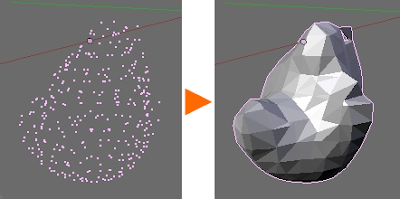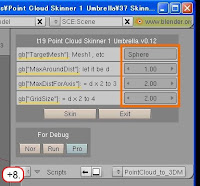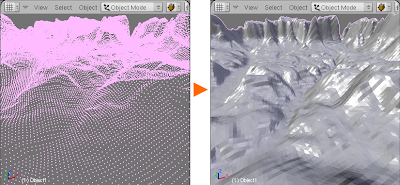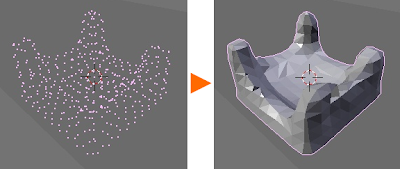(If you use Blender 2.6x or later, please use new Point Cloud Skinner v0.16 or later instead.)
What is Point Cloud Skinner first:
This is a Python script for Blender and allows you to create a surface from only a cloud of vertices. You can get a complete 3D mesh out of just vertices that have no faces.
Name:
Point Cloud Skinner v0.14
Download:
Point_Cloud_Skinner_v0_14_Pub20100110.zip
Main features:
This script, Point Cloud Skinner can skin a cloud of vertices, which means to create a 3D surfaced mesh out of just a cloud of vertices that has no faces. It can skin any shapes of point clouds, such as a surveyed geography point cloud that represents a landform somewhere, a fluid volumetric point cloud obtained by numerical fluid simulation, or anything you like. You can see sample meshes that the script produced in the part Results below.


Results:
You can see the results of using this script, which are point clouds before skinning (left) and the skinned 3D meshes from those point clouds (right).
These two examples below show how the script works for the type of point clouds which is the surveyed geography data like Digital Terrain Model (DTM).

These two examples below show how the script works for the type of point clouds which is the calculated fluid volumetric data.

Video tutorial to start quickly
If you want to know how to use quickly, it would be the fastest way to see this video tutorial. [mirror video]
Start to use easily:
+1. Download the file “Point_Cloud_Skinner_v0_14_Pub20100110.zip” at here. Then unzip it and put the file “t19_PointCloudSkinner1_Umbrella.py” somewhere.
+2. Start Blender.
+3. Split the area and get window two-pane, and change Window Type from 3D View to Text Editor in the right window.
+4. Have a point cloud to skin. For example, select “Add >> Mesh >> IcoSphere” from the menu, set Radius to 1.5 in the displayed menu and click OK. You will get a sphere mesh. Then press the key Tab to change to Edit Mode and press the key X to display the menu Erase. Select Edges & Faces to delete all but vertices. You will get a point cloud of a sphere.
+5. Select “Text >> Open” from the menu and select the .py file that you downloaded at the step +1. The script code can be opened.
+6. Select “Text >> Run Python Script” from the menu. The script will start.
+7. Set the first parameter gb[“TargetMesh”] to the Mesh name that you want to skin, for example “Sphere”, which you created at the step +4. Be careful that it is NOT the Object name, but the Mesh name.
+8. Set the next parameters gb[“MaxAroundDist”] to 1.0, gb[“MaxDistForAxis”] to 2.0, and gb[“GridSize”] to 2.0 in this case. (The parameter gb[“MaxAroundDist”] should be set to the average distance between the closer vertices in your cloud, gb[“MaxDistForAxis”] should be set to two or three times larger value than that, and gb[“GridSize”] should be set to two to four times larger value.)
+9. Click the button Skin. The point cloud will get skinned and you will see an original 3D sphere.


More video demos
If you want to see more about how it works on various point clouds, please check up the following video demos.
 How the script skins the point clouds of a geography and fluid volumetric. [mirror video]
How the script skins the point clouds of a geography and fluid volumetric. [mirror video]
 How the script skins the point clouds of a suzanne, one of the famous pre-defined mesh in Blender.
How the script skins the point clouds of a suzanne, one of the famous pre-defined mesh in Blender.
 How the script skins the point clouds of all Clems data, a huge geography that has around 130,000 vertices.
How the script skins the point clouds of all Clems data, a huge geography that has around 130,000 vertices.
More advanced usage
 Connect two spheres of UVsphere and Icosphere using the script.
Connect two spheres of UVsphere and Icosphere using the script.
Requirements
I confirmed Point Cloud Skinner worked well on Blender v2.45-2.48.
Homepage for details
Please go to the homepage for more details.
Information:
the reason why I made the script, the list of change logs, the future works and more
Algorithm:
Explanation of how the script t15 skins point cloud
Settings:
Explanation of how to setup the parameters of the script t23
List of another notes and memos:
Notes and memos
Have fun! Please give me your opinions about this.







